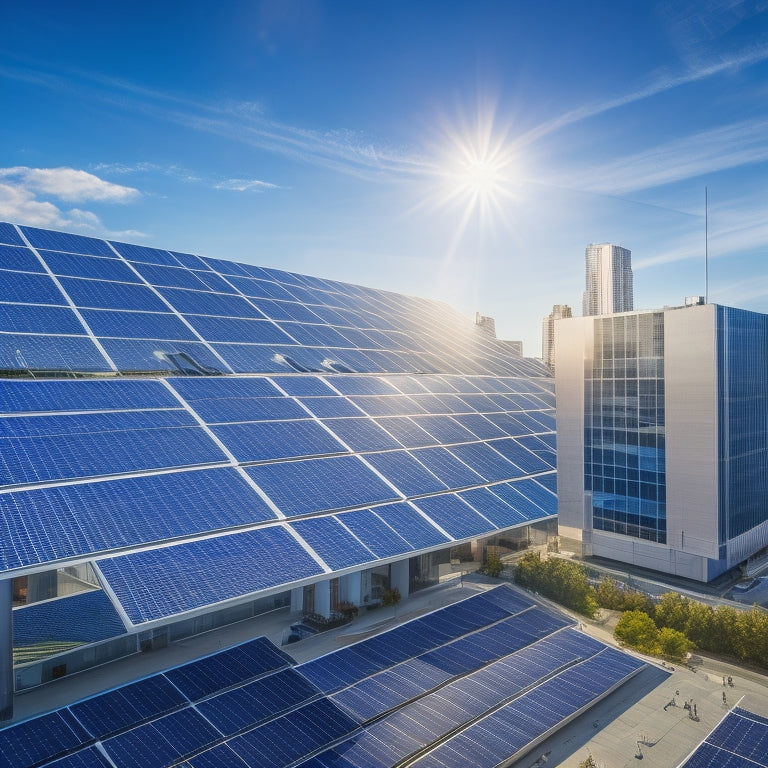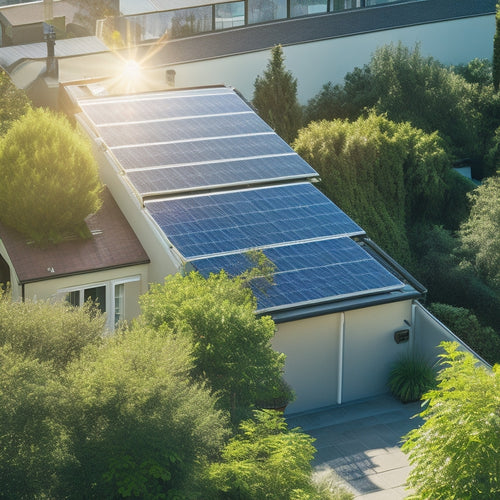
What to Consider When Installing Solar Panels in Office Buildings
Share
When installing solar panels in your office building, you'll need to evaluate several key factors. First, assess your building's suitability by evaluating its solar orientation, shading analysis, and roof condition. Then, evaluate your energy consumption needs by analyzing your current energy usage, peak hour demand, and energy storage solutions. You'll also need to choose the right solar panel based on efficiency ratings, warranty options, and manufacturer reputation. Additionally, assess roof size and condition, budgeting for installation costs, and navigating local building codes. As you weigh these considerations, you'll be well on your way to making an informed decision that meets your office building's unique needs - and that's just the beginning.
Key Takeaways
- Assess the office building's solar orientation, shading, roof condition, and local regulations to ensure a suitable installation.
- Evaluate energy consumption needs, including current usage, peak hour demand, and energy storage solutions to optimize the system.
- Set clear energy efficiency goals, identify areas for improvement, and research financial incentives to guide the installation process.
- Choose the right solar panel based on efficiency ratings, warranty options, technology, and manufacturer reputation to meet energy needs and budget.
- Consider roof size and condition, installation complexity, and budgeting for upfront costs, long-term savings, and maintenance costs to ensure a successful installation.
Assessing Office Building Suitability
Before installing solar panels in an office building, it's essential to assess the building's suitability for a solar panel system.
You'll want to evaluate the building's solar orientation, which refers to the direction and angle of the roof in relation to the sun. A south-facing roof with a slope between 15° and 40° is ideal for capturing sunlight. However, if your building has a flat roof or faces east or west, you can still install solar panels, although the energy output may be lower.
Next, conduct a shading analysis to identify any obstacles that may block sunlight from reaching the solar panels. This includes nearby buildings, trees, and design features like skylights or vents.
You can use software or consult with a solar panel professional to perform a shading analysis and determine the best placement for your solar panels.
Evaluating Energy Consumption Needs
When evaluating energy consumption needs, you'll need to determine your current energy usage patterns, including your peak hour demand, to accurately size your solar panel system.
You'll also want to establish energy efficiency goals, such as reducing your reliance on the grid or achieving net-zero energy status.
Current Energy Usage
Your office building's energy usage patterns play an integral role in determining the feasibility of installing solar panels. Understanding your current energy consumption is vital to identifying areas where solar power can make a significant impact.
Conducting an energy audit can provide beneficial revelations into your energy usage habits, helping you pinpoint opportunities to reduce energy waste and optimize your energy consumption. This audit will also help you determine the size of the solar panel system required to meet your energy needs.
You can take advantage of utility incentives, such as rebates and tax credits, to offset the cost of the solar panel installation. These incentives vary depending on your location, so be sure to research what's available in your area.
Peak Hour Demand
Understanding your office building's peak hour demand is vital to evaluating your energy consumption needs. Peak hour demand refers to the highest amount of electricity your building uses during a specific time period, usually during the hottest summer afternoons when air conditioning systems are running at full capacity.
To determine your peak hour demand, you'll need to analyze your energy usage patterns over a year, considering factors like occupancy rates, lighting, and HVAC systems.
Accurately evaluating your peak hour demand is essential for designing an effective solar panel system that can meet your energy needs. You'll want to contemplate implementing demand response strategies, which involve reducing energy consumption during peak hours to avoid energy waste and lower your utility bills.
Energy storage solutions, such as batteries, can also help mitigate peak hour demand by storing excess energy generated by your solar panels during the day for use during peak hours.
Energy Efficiency Goals
Setting energy efficiency goals is an important step in evaluating your office building's energy consumption needs, as it helps you identify areas for improvement and determine the ideal size of your solar panel system. By doing so, you'll be able to pinpoint opportunities to reduce your energy consumption, which will, in turn, reduce your reliance on the grid and lower your energy bills.
Conducting energy audits is a vital part of this process, as they provide a thorough assessment of your building's energy usage.
These audits will help you identify energy-intensive areas, such as lighting and HVAC systems, and provide recommendations for improvement.
You can then use this information to develop sustainability initiatives that align with your energy efficiency goals.
Choosing the Right Solar Panel
When it comes to utilizing the sun's energy in your office building, selecting the right solar panel is vital. You'll want to take into account factors that impact panel efficiency, as this directly affects the amount of energy generated.
Look for panels with high efficiency ratings, typically above 20%. This guarantees you're getting the most power per hour of sunlight.
Additionally, warranty options are significant. A thorough warranty can provide peace of mind and protect your investment. Look for manufacturers offering at least a 25-year warranty on the panels themselves, as well as a 10-year warranty on inverters and other components. This guarantees you're covered in case of defects or malfunctions.
It's also important to take into account the type of solar panel technology. Monocrystalline and polycrystalline panels are popular options, each with their own advantages.
Monocrystalline panels offer higher efficiency, while polycrystalline panels are more budget-friendly. Ultimately, the right panel for you'll depend on your energy goals and budget.
Roof Size and Condition Considerations
When you're planning to install solar panels on your office building's roof, you'll need to assess the available space to determine how many panels can fit.
You'll also need to take into account the roof's material and condition, as certain materials may not be compatible with solar panels or may require additional installation considerations.
Roof Space Availability
As you assess your office building's potential for solar panel installation, take stock of the roof's size and condition, considering whether it can accommodate the necessary infrastructure. A significant aspect to evaluate is roof space availability, which directly impacts the number of solar panels you can install.
Assess the roof's square footage and identify any obstacles, such as skylights, vents, or HVAC units, that could limit panel placement.
Conduct a solar orientation analysis to determine the best placement of panels based on the roof's direction and angle. This analysis will help you maximize energy production by identifying the areas that receive the most sunlight throughout the day.
Additionally, perform a shading analysis to identify any potential shading issues caused by surrounding buildings, trees, or other obstructions.
Roof Material Compatibility
Your office building's roof is a critical component in the solar panel installation process, and its material compatibility plays a significant role in determining the feasibility of the project. The type and condition of your roof will impact the installation's complexity, cost, and overall performance.
For instance, a roof with a steep slope may require additional structural support, increasing the installation cost. On the other hand, a roof with a gentle slope can provide an ideal surface for solar panels.
When evaluating your roof's material compatibility, you should consider factors such as the age, condition, and type of roofing material. Asphalt shingles, metal, and concrete tiles are common roof materials that can support solar panels.
However, roofs with skylights, vents, or other obstructions may require additional planning and customization. A shading analysis should also be conducted to identify potential shading issues from surrounding structures or trees.
Budgeting for Installation Costs
You'll need to allocate a significant portion of your budget to cover the upfront costs of installing solar panels in your office building. The cost of solar panels, inverters, and mounting hardware can add up quickly, so it's crucial to plan accordingly.
On average, the cost of a commercial solar panel system ranges from $2.50 to $3.50 per watt, depending on the system size and quality of equipment.
Fortunately, there are financing options available to help offset the initial investment. You may be eligible for tax incentives, such as the Solar Investment Tax Credit (ITC), which can provide a significant tax credit for qualified solar panel installations.
Additionally, many states and utilities offer rebates and incentives for commercial solar installations. Be sure to research these opportunities to maximize your savings.
Navigating Local Building Codes
Before commencing the solar panel installation process, it's vital to familiarize yourself with local building codes and regulations that govern commercial solar installations in your area.
Failure to comply with these codes can lead to costly rework, fines, or even project cancellation.
To guarantee a smooth permitting process, consider the following:
-
Building Code Requirements: Review local building codes, such as the International Building Code (IBC) or the International Energy Conservation Code (IECC), to understand specific requirements for solar panel installations in your area.
-
Electrical Code Compliance: Verify that your installation meets the National Electric Code (NEC) standards, which cover electrical safety and wiring requirements.
-
Zoning Ordinances: Check local zoning ordinances to confirm that solar panels are permitted on your office building's rooftop or in the parking area.
Ensuring Safe Installation Practices
Safety takes center stage when installing solar panels in office buildings, as it directly impacts the well-being of installation teams, building occupants, and the general public. You must guarantee that your installation team undergoes thorough safety training to mitigate potential risks associated with heights, electrical systems, and heavy equipment. This training should cover essential topics such as fall protection, electrical safety, and proper lifting techniques.
When it comes to installation techniques, you should prioritize adherence to industry-recognized standards and best practices. This includes confirming that all electrical connections are secure, and that the solar panel system is properly grounded.
You should also implement a quality control process to verify that all components are installed correctly and meet the manufacturer's specifications.
Additionally, you should establish a clear communication plan to coordinate with building occupants and management during the installation process. This will help minimize disruptions and guarantee that everyone is aware of potential hazards.
Monitoring and Maintenance Requirements
Implementing a thorough monitoring and maintenance strategy is essential for ensuring your solar panel system operates at peak performance and ideal energy output. This involves tracking the system's performance in real-time, identifying potential issues, and addressing them promptly.
Performance monitoring enables you to optimize energy production, reduce downtime, and extend the system's lifespan.
You'll want to reflect on the following key aspects of monitoring and maintenance:
-
Remote monitoring: Employ cloud-based software to track your system's performance remotely, receiving alerts and notifications when issues arise.
-
Routine maintenance schedules: Establish regular maintenance schedules to inspect and clean the panels, inverters, and other system components.
-
Data analysis and reporting: Regularly review performance data to identify trends, optimize energy output, and detect potential issues before they become major problems.
Frequently Asked Questions
Can I Install Solar Panels on a Leased Office Building?
You'll need to review your lease agreements to determine if you can install solar panels on a leased office building, obtaining installation permissions from your landlord or building owner before moving forward with the project.
How Do I Handle Potential Panel Damage From Office Building Renovations?
When renovating your office building, you'll want to guarantee your solar panels remain intact; implement panel protection strategies, like covering or removing panels during construction, and consider renovation timing to minimize panel exposure to potential damage.
Are There Any Tax Benefits for Office Building Solar Panel Installations?
You'll benefit from tax credits and investment incentives when installing solar panels; the Solar Investment Tax Credit (ITC) allows you to claim 26% of the total cost as a credit, greatly reducing your tax liability and increasing your ROI.
Can I Sell Excess Energy Generated Back to the Grid?
You'll want to investigate net metering options and energy buyback programs, which allow you to sell excess energy back to the grid, offsetting your utility bills and increasing your investment's ROI, while also reducing your carbon footprint.
Will Solar Panels Affect My Office Building's Insurance Policy?
When you install solar panels, you'll need to review your office building's insurance policy, as it may require policy adjustments to guarantee adequate insurance coverage for the new equipment and potential risks, such as electrical or fire hazards.
Conclusion
As you prepare to install solar panels in your office building, remember that a well-planned project requires careful consideration of multiple factors. By evaluating your building's suitability, analyzing energy needs, and choosing the right solar panel, you'll be well on your way to utilizing renewable energy. Did you know that a typical commercial solar panel system can save up to $500 per year on electricity costs? With the right approach, you can maximize your ROI and reduce your carbon footprint.
Related Posts
-

How Solar Panels Reduce Electricity Bills
Solar panels can drastically cut your electricity bills by utilizing sunlight to generate your own energy. This decre...
-

Solar Power Backup Solutions During Outages
Solar power backup solutions guarantee you have reliable energy during outages, providing essential power when the gr...
-

Eco-Friendly Home Design Ideas for Beginners
If you're starting your eco-friendly home design expedition, focus on sustainable materials like recycled wood or rec...


